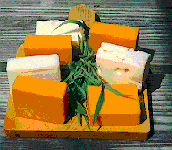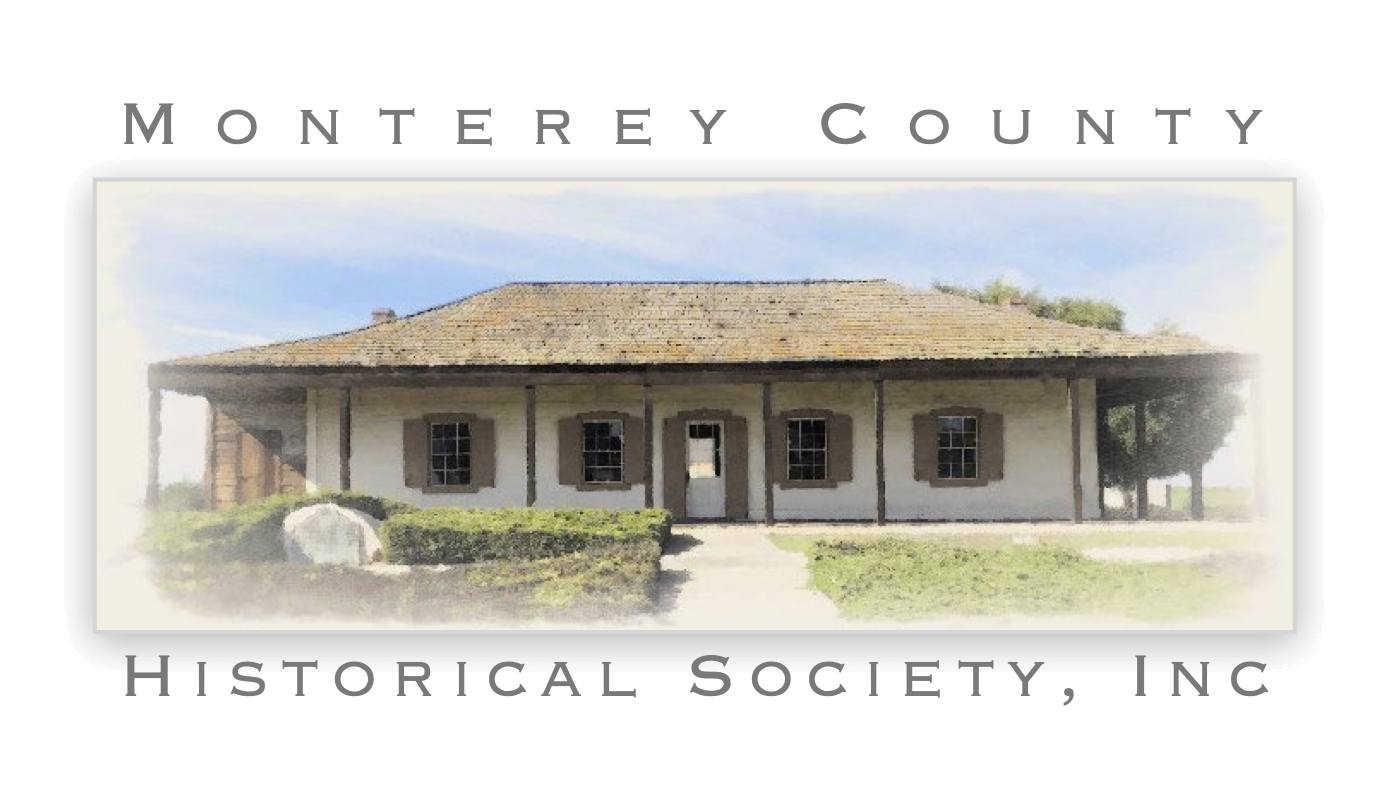by Wendy Moss
This essay was written as a class assignment in SBSC 326: History of the Monterey Bay Area, 10,000 B.C. to Steinbeck, California State University Monterey Bay, Spring Semester 1996.

Who invented Monterey Jack Cheese? Was it David Jacks, the man who lays claim to putting the Jack in jack cheese? Or was it Dona Juana Cota de Boronda? Or Domingo Pedrazzi of Carmel Valley? There are other versions and other stories as well and I think that you will be surprised with what you find out.
What is Monterey Jack Cheese? First, it is one of the four cheeses to supposedly have been created in the United States. It is said to be a “descendent of the semi-soft Italian cheese that fed Caesar’s armies.” A booklet from the Kraft Food Co. dated 1954 calls Monterey jack cheese “a mild buffet and sandwich cheese made something like cheddar.” The connection to cheddar is due to the manufacturing process that is similar, although without dye. Monterey Jack is also compared as a “granular cheese similar to Wisconsin brick.” Lastly and most importantly is that Monterey jack is a descendant of “Queso del Pais” which translates as “country cheese.”
For more than half a century there has been an ongoing debate over who actually created Monterey Jack Cheese and the characters who tell the story are as interesting as those who created it. First I’ll tell you how the “jack” got put into the cheese–the official title was given by the Food and Drug Administration of The United States of America sometime in the fall of 1955. “The name has been sanctioned ‘pursuant to the authority vested in the Secretary of Health, Education and Welfare by the Federal Food, Drug and Cosmetic Act,’ according to a bulletin just received from Washington D.C.” This is taken from an article in the Monterey Peninsula Herald dated Wednesday, Oct. 5, 1955. That does not mean that Jack’s Monterey or Monterey jack had not been used prior to the official title being designated.
Now comes the tricky part–who first manufactured and marketed jack cheese? In 1859, records from The Curtis and Conover Store state that “A.W. Billings shipped out five boxes of cheese on August 27, 1859 and paid $1 to have them hauled to the wharf and shipped.” His actions were repeated over later months. “Two other people were also shipping cheese at the same time as Mr. Billings. I. Shaw shipped cheese by schooner in September, 1859, and Miguel Allen (of the Boronda family) bought ‘1 cheese hoop’ for $2.” These records are based on one store’s records only, and there were several others in the area that dealt with shipping items. There is also a note in the records that no individual cheese sales had taken place from this particular commercial retailer, so the common deduction is that either people were making their own or buying from certain individuals in the area.
One individual who is known to have manufactured and sold “Queso del Pais” door-to-door is Dona Juana Cota de Boronda. Dona Boronda took on this effort after an accident crippled her husband and left her to fend for her family of 17, fifteen children as well as she and her husband. On the family property behind the historic adobe built by her husband there once stood the remains of an old cheese factory.
Another individual who apparently manufactured cheese was Domingo Pedrazzi of Carmel Valley. S.F.B. Morse asserts that Domingo created a cheese that required “the application of pressure.” The pressure was applied with a device called a “housejack” hence, jack cheese. “He developed a fine cheese, and it became known as Pedrazzi’s jack cheese”–jack not Jacks. Later the cheese was marketed as “Del Monte Cheese,” a name which was still used in 1955. “None of the Jacks family had anything to do with it as far as I know,” stated Mr. Morse.
Now David Jacks lays claim to Monterey jack cheese with the shrewdness of a business man. He upscaled the dairy operation and stole the idea of “Queso del Pais.” With 60,000 acres of prime land and 14 dairy ranches that’s easy to do. Supposedly he was in business with Swiss and Portuguese investors. Jacks marked the cheese as “Jacks’ Cheese.” According to the Jacks story, the name was finally changed because so many customer’s were asking for the cheese made by “Monterey Jack.”
So who really invented the cheese that became the famous Monterey jack cheese we know today? Franciscans in the 1700s! Monterey Jack cheese was brought from Spain, via Mexico by the Franciscan Monks of the 18th century. Prior to Spain, the cheese came through Majorca via Romans from Italy. Hence, being a “descendent of the semi-soft Italian cheeses that fed Caesar’s armies.”
Sources:
- Anonymous, excerpt from “Point’s of Interest” (What’s Doing, November 1947, p. 5).
- Anonymous, “It Happened in Monterey” (The Monterey Herald, July 11, 1973).
- O’Donnell, Mayo Hayes, “Here is More on Jack Cheese” (The Monterey Herald, December 11, 1950).
- O’Donnell, Mayo Hayes, “More About Monterey Jack Cheese” (The Monterey Herald, January 2, 1951).
- O’Donnell, Mayo Hayes, “Our Own Monterey Jack Cheese” (The Monterey Herald, November 8, 1959).
- Phillips, C.A., “The Manufacture of Monterey Cheese” (The College of Agriculture, University of California, September 1927).
- Sorri, Fred, “Government Puts ‘Jack’ In Monterey Cheese” (Monterey Peninsula Herald, October 5, 1955).
Excerpts from a letter received from Teresa Russell, summer 1996:
Wendy wrote a wonderful article about Dona Boronda’s Jack Cheese. She is (was) my Grandmother.
The name “jack” is from the use of a vice she made the cheese with. My dad, Ralph Russell (now 76 years old) lived on Rancho Los Gatos, with his mother (Charlotte Espinosa) at Russell and Espinosa Roads in Castroville. The Espinosas and Borondas came to California on pack trains in the 1700s. Dona Boronda brought her cheese recipe with her and started a dairy operation. The “jack” was a “vice.”
My dad tells about how the milk was poured down into this jack device, and as it turned to cheese, it was squeezed between wooden paddles of the vice/jack that fit in the box. The handles were pulled together and bound by leather straps to hold the cheese. The whole gizmo was called a jack, because it pressed the cheese.
The Borondas sold this cheese to a man named [David] Jacks, who had a store. Jacks also exported the cheese on ships out of Monterey. Jacks identified his crates by stamping them “Jack Cheese.”
But the original method of using a jack to make the cheese came from Espinosa Spain. (The Boronda and Espinosa families both came from Spain).
Sincerely,
Teresa Russell [y Espinosa de Boronda]
[Used with permission and slightly edited.]


